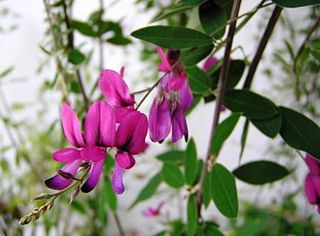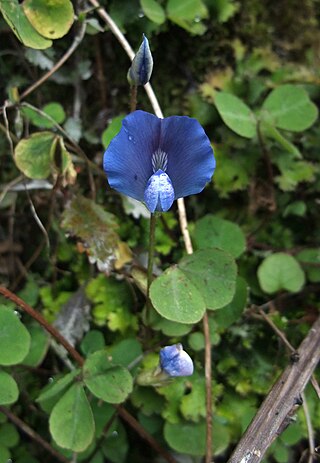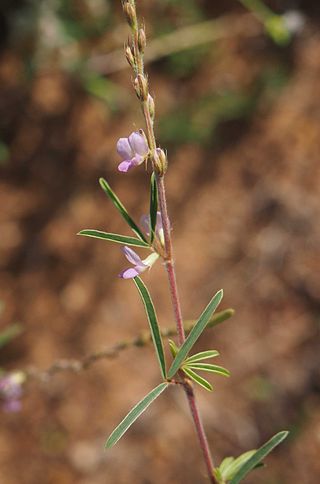
The Faboideae are a subfamily of the flowering plant family Fabaceae or Leguminosae. An acceptable alternative name for the subfamily is Papilionoideae, or Papilionaceae when this group of plants is treated as a family.

Lespedeza is a genus of some 45 species of flowering plants in the pea family (Fabaceae), commonly known as bush clovers or Japanese clovers (hagi). The genus is native to warm temperate to subtropical regions of eastern North America, eastern and southern Asia and Australasia.
Leslie Pedley was an Australian botanist who specialised in the genus Acacia. He is notable for bringing into use the generic name Racosperma, creating a split in the genus, which required some 900 Australian species to be renamed, because the type species of Acacia, Acacia nilotica, now Vachellia nilotica, had a different lineage from the Australian wattles. However, the International Botanical Congress (IBC), held in Melbourne in 2011, ratified its earlier decision to retain the name Acacia for the Australian species, but to rename the African species.

Parochetus communis, known in English as shamrock pea or blue oxalis, is a species of legume, and the only species in the genus Parochetus and in the subtribe Parochetinae. It is a low-growing plant with blue papilionaceous flowers and clover-like leaves. It is found in the mountains of Asia and tropical Africa, and has been introduced to New Zealand.

Desmodium paniculatum, the panicled-leaf ticktrefoil, narrow-leaf tick-trefoil or panicled tickclover, is a perennial herb in the pea family, Fabaceae. Belonging to a nearly cosmopolitan genus, the panicled-leaf ticktrefoil is a common native to Eastern North America, ranging from Quebec to Florida and as far West as Texas, Nebraska, and Ontario. The sticky loment can be found in disturbed areas that receive plenty of light, such as roadsides, parks, and abandoned fields.

Aphyllodium is a genus of flowering plants in the family Fabaceae. It belongs to the subfamily Faboideae. Members of the genus are found in various parts of Australia, South Asia, Southeastern Asia, and south China.

Hylodesmum is a genus of flowering plants in the family Fabaceae, sometimes called ticktrefoils or tick-trefoils. It is sometimes treated as part of Desmodium. It includes 16 species native to eastern North America, sub-Saharan Africa, Yemen, south, southeast, and eastern Asia, Malesia, and New Guinea.
Leptodesmia is a genus of flowering plants in the legume family, Fabaceae. It belongs to the subfamily Faboideae. It includes four species ranging from Madagascar and the Comoros to the Indian subcontinent, Indochina, China, Japan, Malesia, New Guinea, and Queensland.

Phyllodium is a genus of flowering plants in the family Fabaceae, in the subfamily Faboideae, tribe Desmodieae and subtribe Desmodiinae. Species are found in tropical and subtropical Asia through to northern Australia.

The tribe Desmodieae is one of the subdivisions of the plant family Fabaceae. It is composed of two subtribes, Desmodiinae and Lespedezinae. Recent phylogenetics has this tribe nested within tribe Phaseoleae.

Pedleya acanthoclada, commonly known as thorny pea, is the only species of flowering plant in the genus Pedleya of the family Fabaceae. It is a small shrub with pink or purplish flowers, and leaves in groups of three.

Whitfordiodendron is a genus of flowering plants in the legume family, of Fabaceae. It belongs to the subfamily Faboideae.

Hylodesmum glutinosum is a species of flowering plant in the family Fabaceae. Common names include large tick-trefoil, clustered-leaved tick-trefoil, large-flowered tick-clover, pointed tick-trefoil, beggar's lice and pointed-leaved tick-trefoil. It occurs in eastern Canada, the central and eastern United States, and northeastern Mexico.

Mucuna gigantea, commonly known as burny bean, burney bean, velvet bean or sea bean is a species of liana from the legume family Fabaceae. Its natural range roughly follows the perimeter of the Indian Ocean and includes Africa, India, Malesia, New Guinea and northern Australia. Many parts of the plant - in particular the new growth, flowers and fruit - are covered in fine irritant hairs.
Tateishia is a genus of flowering plants belonging to the family Fabaceae.
Pullenia gunnii is a species of flowering plant in the legume family, Fabaceae. It is the sole species in genus Pullenia.
Parlatoria is a monotypic genus of flowering plants belonging to the family Brassicaceae. It just contains one species, Parlatoria cakiloideaBoiss.
Resia is a genus of plants in the family Gesneriaceae. They are also in the Beslerieae tribe.

Polhillides velutina is a species of flowering plant in the legume family, Fabaceae. It is the sole species in the genus Polhillides. It is an annual, perennial or sub-shrub, that is native to tropical regions of Africa and Madagascar, parts of Asia, New Guinea, and Australia. In Africa, its habitats include woodland and grassland in the Sudanian region, wooded grassland and grassland in the Victoria Basin forest–savanna mosaic, and wooded grassland and grassland in the Somalia-Masai region. It is found at elevations of up to 1,320 m (4,330 ft) above sea level.

Hylodesmum nudiflorum, the naked-flowered tick trefoil, panicled leaf tick trefoil or stemless tick trefoil, is a species of flowering plant in the family Fabaceae, native to eastern North America. A perennial, it is typically found in mature, open woodlands in a variety of soils, preferring those with substantial organic content.












